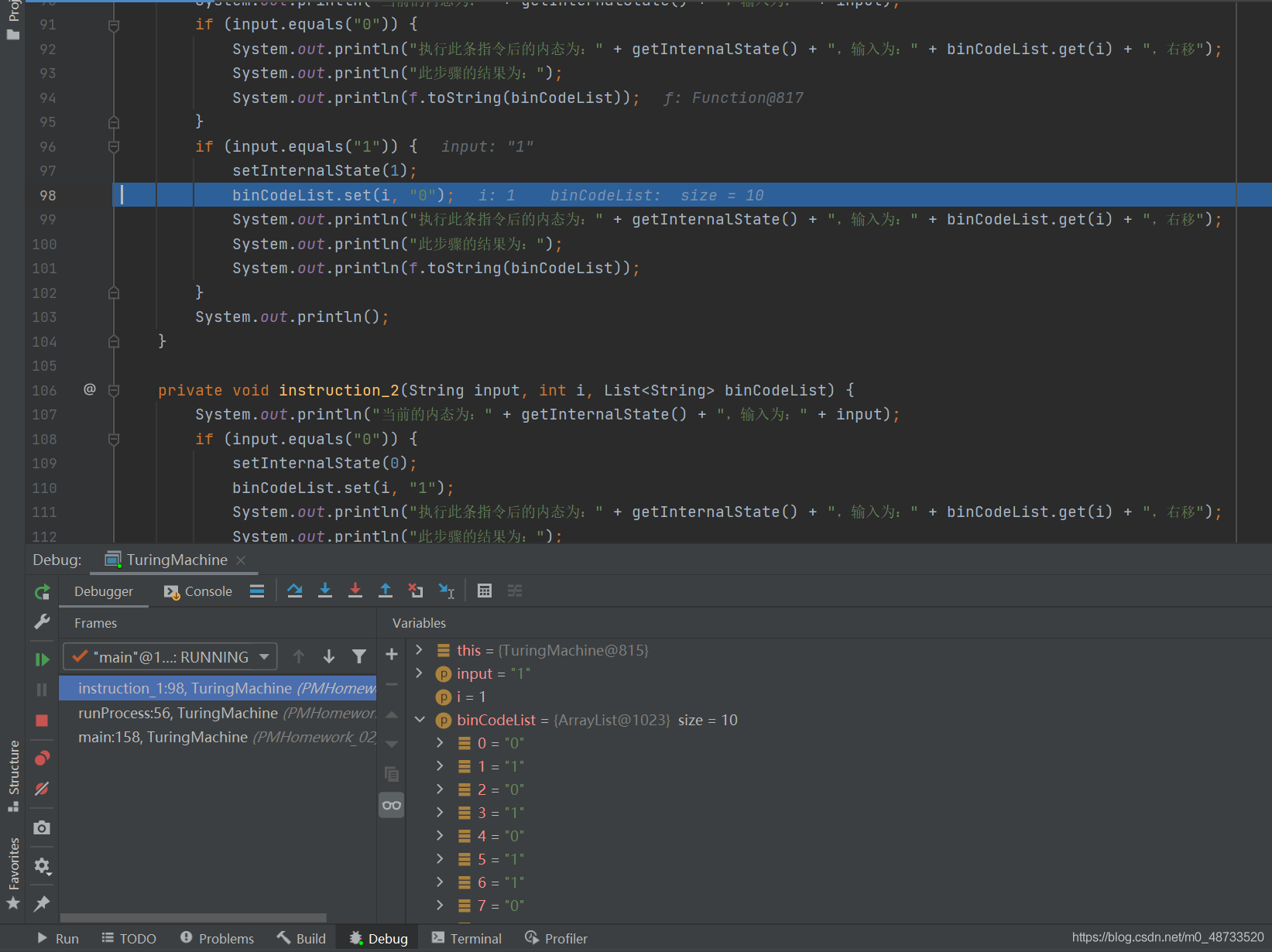如何用Java模擬XN*2圖靈機
題目描述:
對於XN*2圖靈機進行模擬,任意給定的十進制數,轉換為收縮擴展二進制的編碼,再編程模擬此Turing機的運行過程,要求輸出從開始運行起的每一步驟的結果。用C或C++或Java或Python語言實現程序解決問題。
要求:1. 程序風格良好(使用自定義註釋模板);
2. 提供友好的輸入輸出,並進行輸入數據的正確性驗證。
算法分析:
1. 將十進制數轉換為二進制數;
2. 將二進制數轉換為收縮擴展二進制的編碼;
3. 根據當前的內態和輸入執行XN*2圖靈機的指令;
4. 將結果的二進制編碼轉換為二進制數;
5. 將二進制數轉換為十進制數,實現乘2運算功能。
概要設計:
算法流程圖如下:

測試:
|
輸入的十進制數 |
正確的二進制編碼 |
輸出的二進制編碼 |
正確的運算結果 |
輸出的運算結果 |
|
0 |
0011000 |
0011000 |
0 |
0 |
|
3 |
0101011000 |
0101011000 |
6 |
6 |
|
18 |
0100010011000 |
0100010011000 |
36 |
36 |
運行結果:



調試:
①對調用指令的方法進行調試,開始時binCodeList的size為0,導致執行binCodeList.set(i, “0”)時出現錯誤,進過調試後發現是因為沒給方法設置binCodeList的參數,導致方法中用的是類中空的binCodeList。在方法的參數中加上List<String> binCodeList就可以解決。

②對將二進制編碼轉換為十進制數的方法進行調試,開始時運算結果出現錯誤,調試後發現是判斷第i個字符為1,第i+1個字符為0後,沒有將i再加1,導致下次循環又遍歷到i+1的0,於是有些步驟結果就會多出0。在if (binCode.charAt(i + 1) == ‘0’){…}代碼塊中加上i++就可以解決。

源代碼:
import java.util.*;
/**
* @description: 該類模擬XN*2圖靈機,對任意給定的十進制數,轉換為收縮擴展二進制的編碼,並可輸出運行中每一步驟的結果
*/
public class TuringMachine {
private int internalState; // 圖靈機的內態
private String binCode; // 二進制編碼
Function f = new Function(); // 需要用到的方法
List<String> binCodeList = new ArrayList<>(); // 用來存放二進制編碼
static int r = 0; // 當r為1時機器向右移動一格
static int s = 0; // 當s為1時機器停止運行
TuringMachine() {
internalState = 0;
binCode = "0";
}
public int getInternalState() {
return internalState;
}
public void setInternalState(int internalState) {
this.internalState = internalState;
}
public String getBinCode() {
return binCode;
}
public void setBinCode(String binCode) {
this.binCode = binCode;
}
/**
* @description: 模擬圖靈機的運行過程
* @param: [binCode 二進制編碼]
* @return: void
*/
public void runProcess(String binCode) {
binCodeList = f.toArrayList(binCode); // 將二進制碼binCode轉換為ArrayList類型存放在binCodeList中
// for循環對binCodeList進行遍歷,根據當前內態的值判斷該執行哪條指令
for (int i = 0; i < binCodeList.size(); i++) {
r = 1;
// 當s==1時機器停止,跳出循環
if (s == 1) {
break;
}
switch (getInternalState()) {
// 內態為0時執行指令1
case 0:
instruction_1(binCodeList.get(i), i, binCodeList);
break;
// 內態為1時執行指令2
case 1:
instruction_2(binCodeList.get(i), i, binCodeList);
break;
// 內態為10時執行指令3
case 10:
instruction_3(binCodeList.get(i), i, binCodeList);
break;
// 內態為11時執行指令4
case 11:
instruction_4(binCodeList.get(i), i, binCodeList);
break;
default:
break;
}
}
System.out.println("XN*2圖靈機計算的最終結果為:");
f.toDecNum(f.toString(binCodeList)); // 將binCodeList轉換為String類型的二進制編碼binCode,再轉換為int類型的十進制數decNum
}
/**
* @description: 根據指令對每一步驟結果進行打印
* 指令1: 0 0 -> 0 0 R
* 0 1 -> 1 0 R
* 指令2: 1 0 -> 0 1 R
* 1 1 -> 10 0 R
* 指令3: 10 0 -> 11 1 R
* 指令4: 11 0 -> 0 1 STOP
* @param: [input 輸入, i 循環的次數從0開始, binCodeList 存放二進制編碼binCode]
* @return: void
*/
private void instruction_1(String input, int i, List<String> binCodeList) {
System.out.println("當前的內態為:" + getInternalState() + ",輸入為:" + input);
if (input.equals("0")) {
System.out.println("執行此條指令後的內態為:" + getInternalState() + ",輸入為:" + binCodeList.get(i) + ",右移");
System.out.println("此步驟的結果為:");
System.out.println(f.toString(binCodeList));
}
if (input.equals("1")) {
setInternalState(1);
binCodeList.set(i, "0");
System.out.println("執行此條指令後的內態為:" + getInternalState() + ",輸入為:" + binCodeList.get(i) + ",右移");
System.out.println("此步驟的結果為:");
System.out.println(f.toString(binCodeList));
}
System.out.println();
}
private void instruction_2(String input, int i, List<String> binCodeList) {
System.out.println("當前的內態為:" + getInternalState() + ",輸入為:" + input);
if (input.equals("0")) {
setInternalState(0);
binCodeList.set(i, "1");
System.out.println("執行此條指令後的內態為:" + getInternalState() + ",輸入為:" + binCodeList.get(i) + ",右移");
System.out.println("此步驟的結果為:");
System.out.println(f.toString(binCodeList));
}
if (input.equals("1")) {
setInternalState(10);
binCodeList.set(i, "0");
System.out.println("執行此條指令後的內態為:" + getInternalState() + ",輸入為:" + binCodeList.get(i) + ",右移");
System.out.println("此步驟的結果為:");
System.out.println(f.toString(binCodeList));
}
System.out.println();
}
private void instruction_3(String input, int i, List<String> binCodeList) {
System.out.println("當前的內態為:" + getInternalState() + ",輸入為:" + input);
if (input.equals("0")) {
setInternalState(11);
binCodeList.set(i, "1");
System.out.println("執行此條指令後的內態為:" + getInternalState() + ",輸入為:" + binCodeList.get(i) + ",右移");
System.out.println("此步驟的結果為:");
System.out.println(f.toString(binCodeList));
}
System.out.println();
}
private void instruction_4(String input, int i, List<String> binCodeList) {
System.out.println("當前的內態為:" + getInternalState() + ",輸入為:" + input);
if (input.equals("0")) {
setInternalState(0);
binCodeList.set(i, "1");
System.out.println("執行此條指令後的內態為:" + getInternalState() + ",輸入為:" + binCodeList.get(i) + ",STOP");
System.out.println("此步驟的結果為:");
System.out.println(f.toString(binCodeList));
}
s = 1;
System.out.println();
}
public static void main(String[] args) {
TuringMachine tm = new TuringMachine(); // 創建TuringMachine的實例tm
System.out.println("請輸入一個十進制數:");
Scanner scanner = new Scanner(System.in);
try {
int decNum = scanner.nextInt();
tm.setBinCode(tm.f.toBinCode(decNum)); // 將十進制數轉換為二進制編碼並賦值給binCode
System.out.println();
tm.runProcess(tm.getBinCode()); // 運行圖靈機
} catch (InputMismatchException ex) {
System.out.println("輸入有誤!");
}
}
}
/**
* @description: 該類具有圖靈機TuringMachine運行過程中所需要的一些方法
*/
class Function {
/**
* @description: 將十進制數轉換為二進制編碼
* @param: [decNum 十進制數]
* @return: java.lang.String
*/
public String toBinCode(int decNum) {
String binCode = "";
String binNum = Integer.toBinaryString(decNum); // 十進制數轉換為二進制數
binNum += ","; // 用,標識此二進制數到此已完整,後面的0都忽略不計
System.out.println("這個數的二進制表示為:" + binNum);
// 利用for循環對二進制數binNum中的字符進行遍歷,根據其中的每個字符得出二進制編碼binCode
for (int i = 0; i < binNum.length(); i++) {
// 0 -> 0
if (binNum.charAt(i) == '0') {
binCode += "0";
// 1 -> 10
} else if (binNum.charAt(i) == '1') {
binCode += "10";
// , -> 110
} else if (binNum.charAt(i) == ',') {
binCode += "110";
}
}
binCode = "0" + binCode + "00";
System.out.println("這個數的二進制編碼為:" + binCode);
return binCode;
}
/**
* @description: 將二進制編碼轉換為十進制數
* @param: [binCode 二進制編碼]
* @return: int
*/
public int toDecNum(String binCode) {
int decNum = 0;
String binNum = "";
// 先利用for循環對ArrayList類型的binCode進行遍歷,根據其中的每個元素得出二進制編碼binCode
for (int i = 0; i < binCode.length(); i++) {
// 0 -> 0
if (binCode.charAt(i) == '0') {
binNum += "0";
} else if (binCode.charAt(i) == '1') {
// 10 -> 1
if (binCode.charAt(i + 1) == '0') {
binNum += "1";
i++;
// 110 -> ,
} else if (binCode.charAt(i + 1) == '1') {
binNum += ",";
break;
}
}
}
System.out.println("二進制表示:" + binNum);
decNum = Integer.parseInt(binNum.substring(0, binNum.length() - 1), 2); // 將二進制編碼binCode轉化為十進制數
System.out.println("十進制表示:" + decNum);
return decNum;
}
/**
* @description: 將二進制編碼binCode存放到binCodeList中
* @param: [binCode 二進制編碼]
* @return: java.util.List<java.lang.String>
*/
public List<String> toArrayList(String binCode) {
binCode = binCode.replaceAll("", " ").trim(); // 將binCode中的每個字符用空格分隔開,並去掉首尾的空格
// 根據分隔符空格分隔出binCode中的每個字符存放到binCodeList中
List<String> binCodeList = new ArrayList<>(Arrays.asList(binCode.split(" ")));
return binCodeList;
}
/**
* @description: 將binCodeList轉換為二進制編碼binCode
* @param: [binCodeList 存放binCode的容器]
* @return: java.lang.String
*/
public String toString(List<String> binCodeList) {
String binCode = String.join("", binCodeList);
return binCode;
}
}
總結
本次測試是模擬圖靈機對十進制數進行乘2運算,並輸出每一步驟的結果。
本次測試的關鍵問題在於圖靈機運行過程和算法的理解,圖靈機判斷當前內態和輸入後執行指令,在這裡我才用switch語句根據內態的值判斷執行哪個指令方法,再根據輸入判斷具體執行什麼指令,通過for循環模擬右移操作。到此這篇關於如何用Java模擬XN*2圖靈機的文章就介紹到這瞭,更多相關Java內容請搜索WalkonNet以前的文章或繼續瀏覽下面的相關文章希望大傢以後多多支持WalkonNet!
推薦閱讀:
- None Found